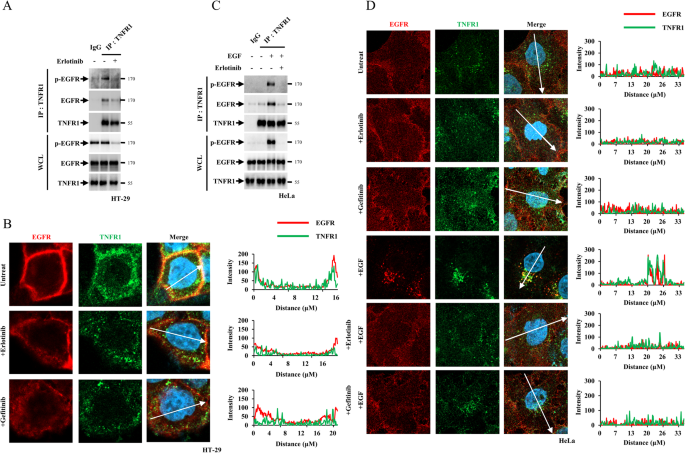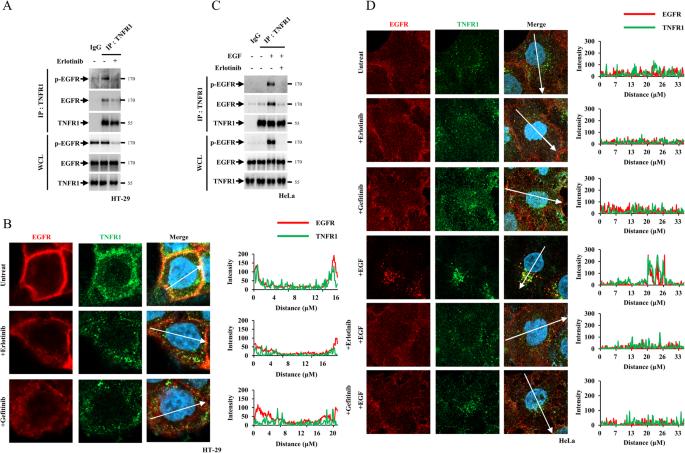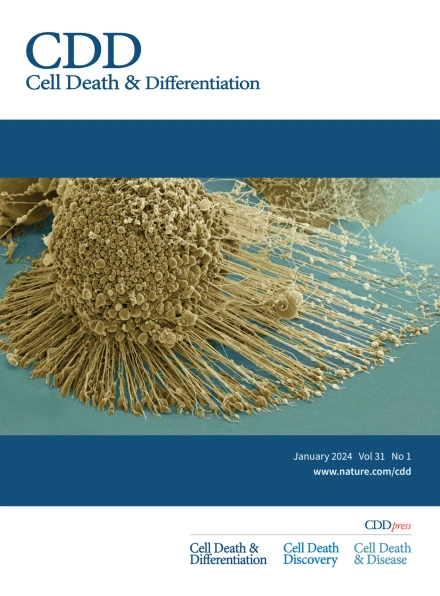EGFR inhibits TNF-α-mediated pathway by phosphorylating TNFR1 at tyrosine 360 and 401
IF 13.7
1区 生物学
Q1 BIOCHEMISTRY & MOLECULAR BIOLOGY
引用次数: 0
Abstract
Tumour necrosis factor receptor 1 (TNFR1) induces the nuclear factor kappa-B (NF-κB) signalling pathway and regulated cell death processes when TNF-α ligates with it. Although mechanisms regulating the downstream pathways of TNFR1 have been elucidated, the direct regulation of TNFR1 itself is not well known. In this study, we showed that the kinase domain of the epidermal growth factor receptor (EGFR) regulates NF-κB signalling and TNF-α-induced cell death by directly phosphorylating TNFR1 at Tyr 360 and 401 in its death domain. In contrast, EGFR inhibition by EGFR inhibitors, such as erlotinib and gefitinib, prevented their interaction. Once TNFR1 is phosphorylated, its death domain induces the suppression of the NF-κB pathways, complex II-mediated apoptosis, or necrosome-dependent necroptosis. Physiologically, in mouse models, EGF treatment mitigates TNF-α-dependent necroptotic skin inflammation induced by treatment with IAP and caspase inhibitors. Our study revealed a novel role for EGFR in directly regulating TNF-α-related pathways.


表皮生长因子受体通过在酪氨酸 360 和 401 处磷酸化 TNFR1 来抑制 TNF-α 介导的途径。
肿瘤坏死因子受体 1(TNFR1)可诱导核因子卡巴-B(NF-κB)信号通路,并在 TNF-α 与之连接时调节细胞死亡过程。尽管TNFR1下游通路的调控机制已被阐明,但TNFR1本身的直接调控机制还不十分清楚。在这项研究中,我们发现表皮生长因子受体(EGFR)的激酶结构域通过直接磷酸化 TNFR1 死亡结构域中 Tyr 360 和 401 的磷酸化来调节 NF-κB 信号和 TNF-α 诱导的细胞死亡。与此相反,表皮生长因子受体抑制剂(如厄洛替尼和吉非替尼)可以阻止它们之间的相互作用。TNFR1 一旦磷酸化,其死亡结构域就会诱导抑制 NF-κB 通路、复合体 II 介导的细胞凋亡或坏死体依赖性坏死。从生理学角度看,在小鼠模型中,EGF 治疗可减轻 IAP 和 Caspase 抑制剂诱导的 TNF-α 依赖性坏死性皮肤炎症。我们的研究揭示了表皮生长因子受体在直接调节 TNF-α 相关途径中的新作用。
本文章由计算机程序翻译,如有差异,请以英文原文为准。
求助全文
约1分钟内获得全文
求助全文
来源期刊

Cell Death and Differentiation
生物-生化与分子生物学
CiteScore
24.70
自引率
1.60%
发文量
181
审稿时长
3 months
期刊介绍:
Mission, vision and values of Cell Death & Differentiation:
To devote itself to scientific excellence in the field of cell biology, molecular biology, and biochemistry of cell death and disease.
To provide a unified forum for scientists and clinical researchers
It is committed to the rapid publication of high quality original papers relating to these subjects, together with topical, usually solicited, reviews, meeting reports, editorial correspondence and occasional commentaries on controversial and scientifically informative issues.
 求助内容:
求助内容: 应助结果提醒方式:
应助结果提醒方式:


